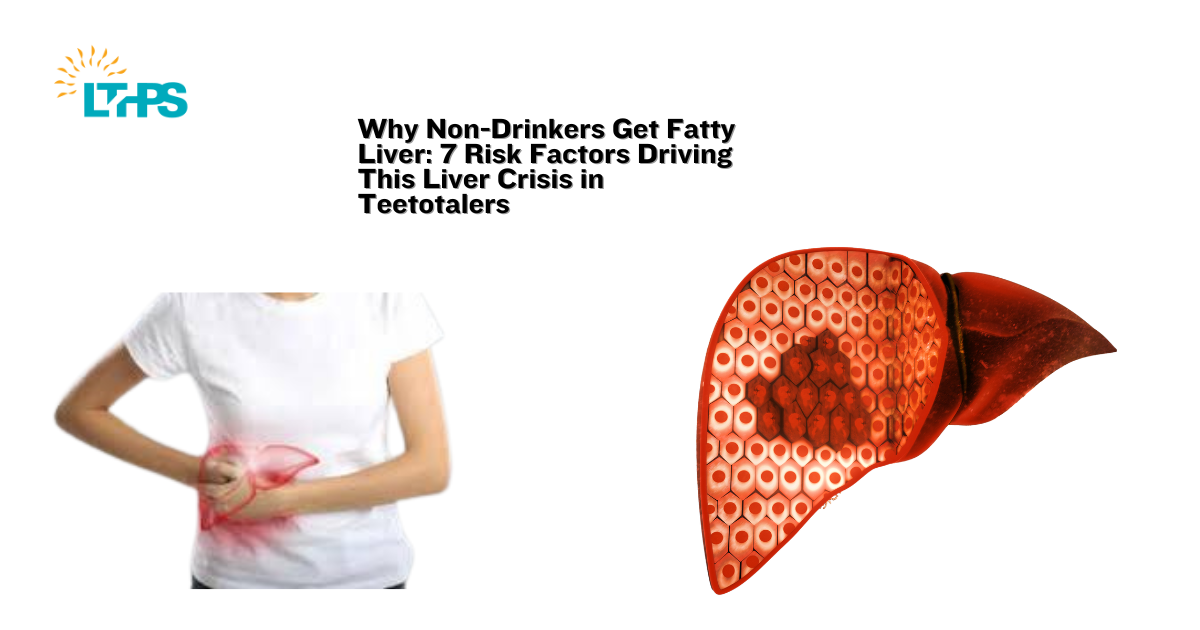Introduction
When we hear “fatty liver,” the first thought that often pops into our mind is alcohol. After all, alcohol-related liver disease is a widely known condition. But here’s the surprising truth — you don’t have to drink a single drop to get a fatty liver. Yes, even people who have never touched alcohol in their lives can develop Non-Alcoholic Fatty Liver Disease (NAFLD).
Think of your liver like a sponge — it soaks up nutrients, processes toxins, and helps keep your body balanced. But when too much fat gets stored in it, the sponge gets heavy and clogged, slowing everything down.
In this article, we’ll explore seven key risk factors that can lead to fatty liver in non-drinkers, how it affects health, and when to seek help from a liver transplant surgeon in India .
- What Exactly Is Fatty Liver For People Who Don’t Drink?
Fatty liver for people who don’t drink is called Non-Alcoholic Fatty Liver Disease, or NAFLD for short. It happens when the liver has more than 5 to 10 per cent fat in it. Unlike the kind of liver disease caused by alcohol, NAFLD is triggered by metabolism and lifestyle choices rather than by booze.
- How Does Fat Pile Up In The Liver If You Don’t Touch Alcohol?
Your liver is like a factory that breaks down everything you eat and drink. If you eat more calories than your body needs, especially from sugary foods and unhealthy fats, the liver ends up packing some of that excess energy away as fat. If the overload keeps happening, the fat keeps stacking up, causing swelling and a more dangerous kind of liver trouble called Non-Alcoholic Steatohepatitis, or NASH for short.
- First Risk Factor: Being Overweight and Having Belly Fat
What’s the Big Deal: Carrying extra weight, and especially extra fat around your belly, makes it more likely that fat will settle in the liver.
Picture it: It’s like lugging an extra-heavy backpack wherever you go. Your legs get tired, your heart has to pump harder, and your liver ends up stressed, too.
- Second Risk Factor: Type 2 Diabetes and Insulin Issues
Too much sugar in the blood and trouble using insulin make it harder for your body to manage how it stores fat. The result? More of that extra fat gets dumped in the liver, and the swelling gets worse.
- Risk Factor #3 – Junk Food Galore
Sodas, chips, and drive-thru meals are crammed with simple sugars and nasty trans fats. They behave like a turbo boost for turning extra calories straight into sauce on the liver.
- Risk Factor #4 – Couch-Potato Vibes
When we skip the workout scene, our bodies’ engines slow down. With fewer calories burned, the scale tips up and extra of that weight gets stored in the liver.
- Risk Factor #5 – Family Playbook
Some of us draw a short straw of genes that make us extra good at storing fat, even if the mirror tells a normal-size story.
- Risk Factor #6 – Hormone Whirlwinds
For some women, PCOS and the wild hormonal ride of menopause dial up the chance of a liver packing extra fat.
- Risk Factor #7 – Meds with Side Effects
Drugs like steroids, tamoxifen, and a few antiviral pills can trick the liver into storing fat, and the problem can grow quietly over months to years.
- How Fatty Liver Gets Serious in Non-Drinkers
If nothing changes, that silent fat can trade-up from simple NAFL to angry NASH, to scarring (fibrosis), then to cirrhosis, and finally to liver failure—where the only fix is a brand-new liver.
- Early Signs You Should Notice
Feeling tired all the time
Gaining weight for no clear reason
Feeling aching in your upper right side
Your ankles or legs puffing up a little
- How Doctors Find Out
Docs might use:
Blood tests to check liver enzymes
An ultrasound or MRI
A FibroScan to check how tight the liver is
A liver biopsy if things look really bad
- Easy Steps to Protect and Heal Your Liver
Stay at a healthy weight
Move your body for 150 minutes or more each week
Put colourful veggies, lean meats, and healthy fats on your plate
Skip sugary drinks and packaged snacks
- Medications and When You Might Need Surgery
Most fatty liver issues get better with healthy habits, but really serious ones could need:
Pills to help with insulin
Vitamin E for some patients
A liver transplant if the damage is too great
- When to Call a Liver Transplant Surgeon in India
If fatty liver turns into bad cirrhosis or liver failure, get in touch with a liver transplant surgeon in India right away. Talking to them early boosts your chances of living and helps you get ready better.
- Conclusion
Fatty liver disease in people who don’t drink is becoming a big health problem. You can have a risky liver without ever touching alcohol. If you know the danger signs and choose smart habits, you can keep your liver healthy and strong.
FAQs
- Can a non-drinker fix fatty liver?
Absolutely. If you catch it early, losing weight, getting active, and eating right can make it go away.
- Is non-drinker’s fatty liver as risky as the kind drinkers get?
Yes. Both can lead to cirrhosis and liver failure if you ignore them, so treat them the same.
- Is getting a liver transplant the only choice when fatty liver is really bad?
Pretty much. When the liver is so damaged it won’t work anymore, a transplant is your best shot at staying alive.
- Does fatty liver hurt at first?
Not usually. Early-stage fatty liver rarely shows signs, so regular check-ups are smart.
- How do I choose a good liver transplant surgeon in India?
Pick someone with a strong track record, a good hospital team, and lots of experience in tough transplant cases.
